Method of Infinite System of Equations for Problems in Unbounded Domains
Abstract
Many problems of mechanics and physics are posed in unbounded (or infinite) domains. For solving these problems one typically limits them to bounded domains and find ways to set appropriate conditions on artificial boundaries or use quasi-uniform grid that maps unbounded domains to bounded ones. Differently from the above methods we approach to problems in unbounded domains by infinite system of equations. In this paper we present starting results in this approach for some one-dimensional problems. The problems are reduced to infinite system of linear equations. A method for obtaining approximate solution with a given accuracy is proposed. Numerical experiments for several examples show the effectiveness of the offered method.
1. Introduction
Many problems of mechanics and physics are posed in unbounded (or infinite) domains, for example, heat transport problems in infinite or semi-infinite bar, aerosol propagation in atmosphere, problem of ocean pollution, wave propagation in unbounded media, and problem of computing the potential distribution due to a source of current in or on the surface of the Earth. For solving these problems one usually restricts oneself to treat the problem in a bounded domain and try to use available efficient methods for finding exact or approximate solutions in the restricted domain. But there arise some questions: which size of restricted domain is enough and how to set conditions on artificial boundary for obtaining approximate solution with good accuracy? The simplest way to do this is to transfer boundary condition on infinity to the artificial boundary. This raw way may lead to large deviation of approximate solution from the solution of the original problem. Therefore, instead of transferring boundary condition on infinity without changes one tries to set appropriate conditions on artificial boundary. This is a direction of researches that attracts the attention of many specialists in the fields of mathematics, mechanics, and physics (see [1–4]). Especially, from the late 1970s for the wave problems the nonreflecting boundary conditions are intensively developed (see [5–7] and bibliography therein).
Recently, a few of Russian mathematicians proposed a new method for problems in unbounded domains. It is the use of quasi-uniform grid for mapping unbounded domain to bounded one [8–12]. This quasi-uniform grid was used after in [13]. Due to this grid the condition on infinity is easily taken into account. Nevertheless, the quasi-uniform grid, as will be shown later by us, cannot satisfy the requirements to describe the wave propagation when the area under interest, which is peak of waves, is covered by very sparse grid points.
Differently from the above methods we approach to problems in unbounded domain by infinite system of linear equations. More precisely, we construct a different scheme for the problem in unbounded domain and suggest a method for treating the infinite system in order to obtain an approximate solution with a given accuracy. This method is based on a theorem about error estimate of the solution of a truncated system obtained from an infinite tridiagonal system. It should be noticed that the reduction of infinite systems of grid equations to finite systems are also considered recently in [14, 15].
In this paper we report some our starting results in the research direction for several one-dimensional stationary and nonstationary problems in unbounded domains. Some numerical examples demonstrate the efficiency of the proposed method and its advantage over the quasi-uniform grid method.
2. Some Concepts and Auxiliary Results
2.1. Infinite System of Equations [16]
We say that a solution x1, x2, … of the system tends to zero if xi → 0 as i → ∞.
Theorem 2.1 (see [16], Theorem Ia.)The regular system (2.1) with the free members satisfying the condition (2.6) has a bounded solution |xi | ≤ K which can be found by the method of successive approximation.
Theorem 2.2 (see [16], Theorem IIb.)A regular infinite system cannot have more than one solution tending to zero. Moreover, if its coefficients and free members are positive then its positive solution tending to zero must be the main solution.
2.2. Quasi-Uniform Grid [8, 10]
3. Method of Infinite System for Stationary Problems
A question that arises here is to which size do we need to truncate the infinite system for obtaining approximate solution with a given accuracy? Below we give answer to this question.
Lemma 3.1. For the coefficients αi and βi there hold the following assertions.
- (i)
0 < αi < 1, (i = 2,3, …) and βi → 0 as i → ∞.
- (ii)
|βi|/(1 − αi) → 0 as i → ∞.
Proof. (i) Analogously as for a finite system of three-point difference equations (see [17]) it is possible to prove by induction that 0 < αi < 1 (i = 2, 3, …). Hence, from the condition yi → 0 and from (3.13) it follows that βi → 0 as i → ∞.
(ii) Since 0 < αi < 1 is proved, from (3.10) and (3.11) we have
Further, taking into account (3.8) and (3.9) we obtain
Put
Then there holds the estimate
Therefore,
The proof of the lemma is complete.
Theorem 3.2. Given an accuracy ε > 0. If starting from a natural number N there holds
Proof. Denote . Then it is easy to see that zi satisfies the infinite system
Remark 3.3. The above theorem permits us in the process of computation of the sweep coefficients (3.14) to determine when to truncate the infinite system (3.9) for guarantee that the solution of the infinite system less than given ε.
Below in order to illustrate the effectiveness of using Theorem 3.2 we consider the following.
Example 3.4.
| ε | N | Error |
|---|---|---|
| 0.01 | 108 | 0.0085 |
| 0.001 | 325 | 0.0012 |
| 0.0001 | 1010 | 0.0012 |
| ε | N | Error |
|---|---|---|
| 0.01 | 215 | 0.0086 |
| 0.001 | 650 | 9.45e − 4 |
| 0.0001 | 2020 | 2.94e − 4 |

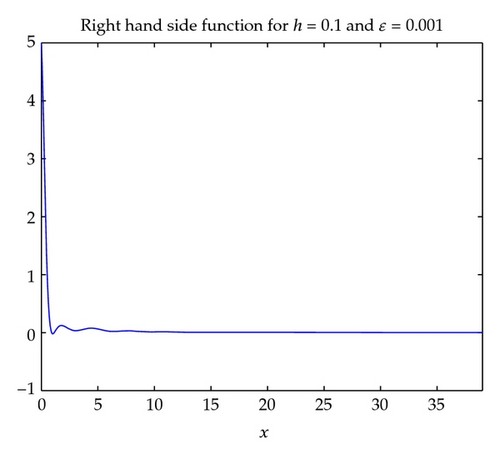
In the process of computation we observe that the coefficients βi tend to zero very fast and the coefficients αi have the trend of approaching to 1 but the ratio βi/(1 − αi) tend to zero rather fast, too. The graphs of the coefficients αi, βi, and the ratio βi/(1 − αi) are given in Figures 3, 4, and 5, respectively.
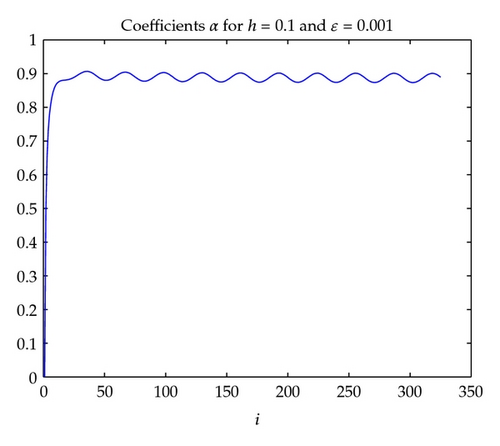
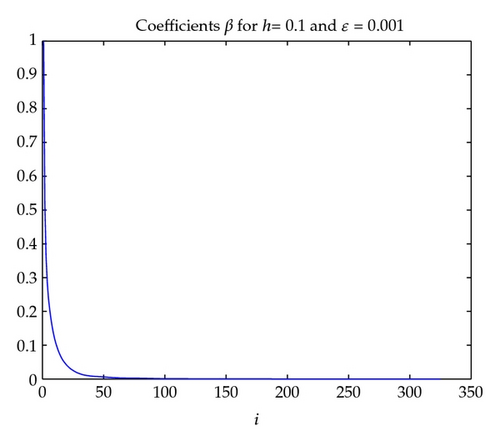
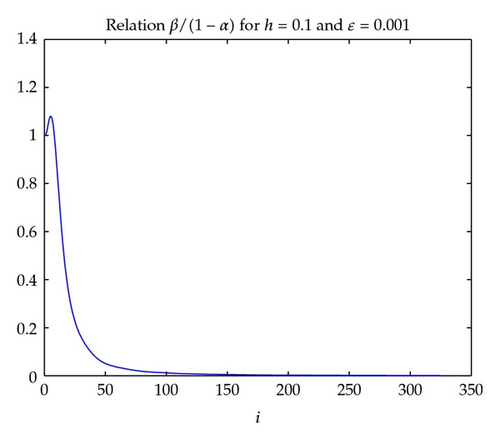
Remark 3.5. The problem in semi-infinite bar for the more general than (3.1) equation , is treated in similar way if for it we construct according to Samarskii [17] a monotone difference scheme.
Remark 3.6. In the case if instead of Dirichlet boundary condition at left end-point there is given Neumann boundary condition then the problem can be treated in similar way.
Remark 3.7. If the functions k(x), d(x), and f(x) in (3.1) are even functions then the problem on the whole real axis with vanishing conditions, that is, u(±∞) = 0, is reduced to the problem on [0, +∞) with the boundary condition u′(0) = 0.
4. Parabolic Equation on Semi-Infinite Bar
- (a)
First we consider the heat conductivity problem with constant coefficient k > 0
()
The system (4.3) is treated in a similar way as for the system (3.6). It is easy to show that at each time layer j + 1 for the sweep coefficients αi and βi we have 0 < αi < r/(1 + r) and βi → 0. So, we can use Theorem 3.2 to truncate the infinite system.
In order to demonstrate the advantage of the infinite system method over the quasi-uniform grid method used in [10, 12] we perform computations by these two methods: infinite system on uniform grid and finite system on quasi-uniform grid xi = i/N − i, (i = 0,1, …, N) with N = 50. Since the density of quasi-uniform nodes is very sparse for i ≥ 25 the profiles of the approximate solution are broken lines. Figures 6 and 7 give the profiles of solution computed by the two methods with k = 10, ε = 0.001. From these figures we see that the infinite system method gives better results.
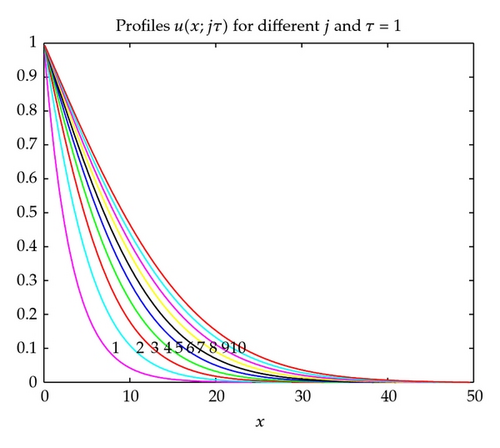
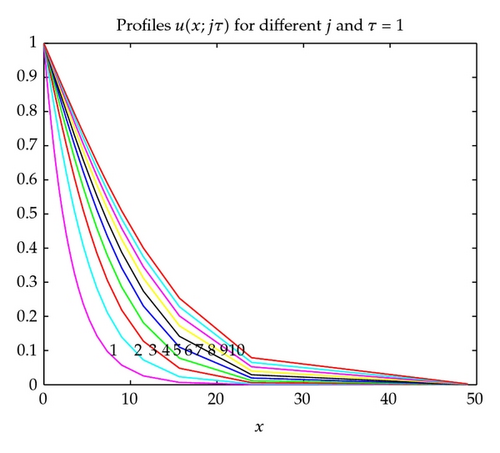
- (b)
The stationary problem of air pollution caused by a point source with constant power Q located at point (0, H) is reduced to the problem
()
The numerical solution of the above problem on uniform grid using the infinite system method was studied in [18], where a theorem similar to Theorem 3.2 was proved.
An interesting fact was established in [20]. It is that if limiting the problem of air pollution to the domain 0 ≤ z ≤ Z with finite Z then artificial boundary condition φ(x, Z) = 0 causes an undershoot and the Neumann condition ∂φ/∂z(x, Z) = 0 causes an overshoot in numerical solution when compared with the solution of the problem with the boundary condition φ(x, +∞) = 0.
5. The Equation of Complex Type
Example 5.1. In this example we take initial conditions be homogeneous and the left boundary condition u(0, t) = arctan2(10t) · sin(0.3t).
The profiles u(x, t) with t = 1,2, …, 10 computed by the infinite system method for h = 0.1 are given in Figure 8 and by the quasi-uniform grid method are given in Figure 9.

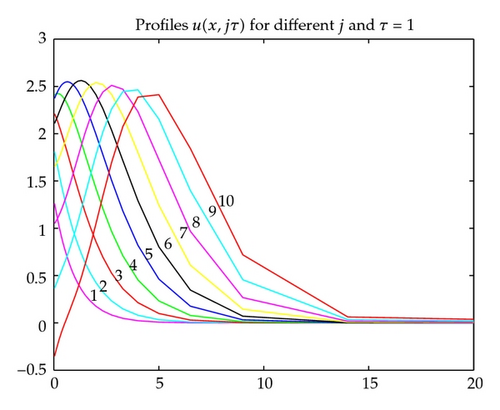
Example 5.2. The left boundary condition is zero, the initial condition is
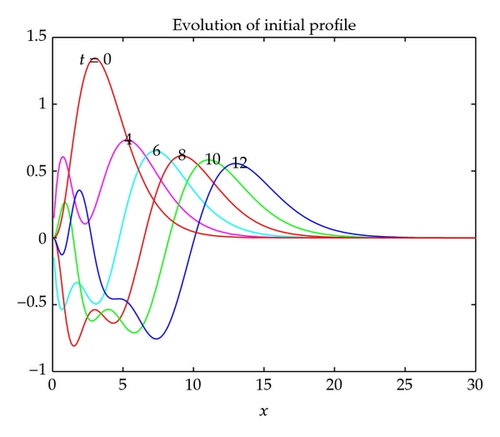
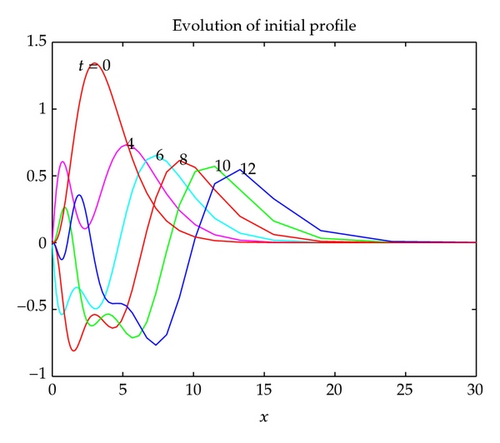
From Figures 8–11 we see that the approximate solution computed by the method of infinite system describes the wave propagation better than the solution obtained by the method of quasi-uniform grid.
6. Concluding Remarks
In this paper we propose and investigate the infinite system method for solving several one-dimensional stationary and nonstationary problems, where the keystone is to determine when truncate the infinite system for assuring to obtain approximate solution with a given accuracy. This method reveals advantage over the quasi-uniform grid method, proposed in 2001 by Russian mathematicians in time-dependent problems, especially in problems of wave propagation.
In combination with the alternating directions method the proposed method can be applied to two-dimensional problems in semi-infinite and infinite strips.
The development of the method for solving other two-dimensional and three-dimensional problems is the direction of our research in the future.
Acknowledgments
This work is supported by Vietnam National foundation for Science and Technology Development (NAFOSTED) under the Grant no. 102.99-2011.24. The authors would like to thank the anonymous reviewers sincerely for their helpful comments to improve the original paper.




